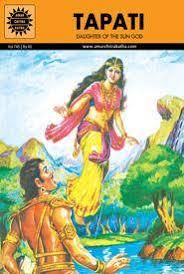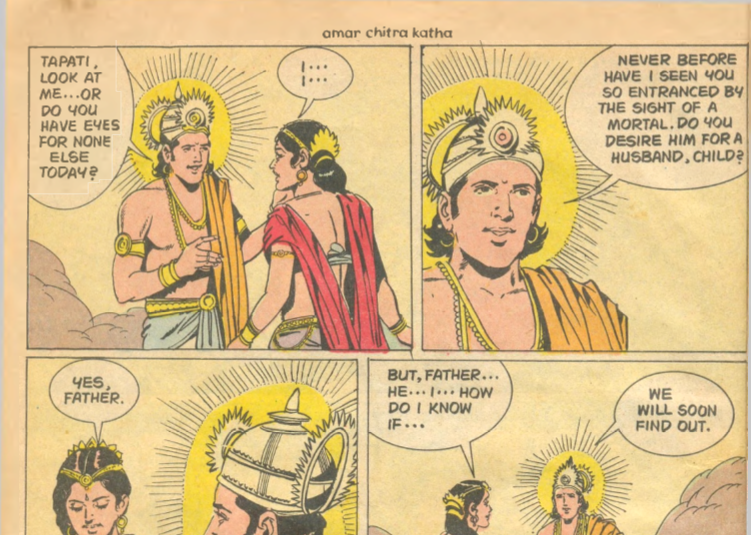So… you’ve read the story of the River Yamuna (if you haven’t yet, click here) Here’s the sequel.
This tale is about yet another Indian water body – the River Tapati (also called Tapti or Tapi). Like the river Yamuna, she too flows from Surya’s illustrious family.
Story of Tapti
In the story a Brother, a Sister and a River of Tears, you read about the family of Surya, comprising the Sun, his wife Sanjana (Cloud Goddess) and their twin children Yama and Yami. There was also Chaya (Shadow), sister of Sanjana who takes Sanjana’s place at her request. And if you remember, Surya and Chaya had children of their own.
Well…this story takes off from that point. (If you haven’t read that story or want to refesh your memory, click here)
Surya and Chaya have three children in all – a son Shani /Saturn (who supposedly inherits his mother Chaya’s dark complexion and sombre coutenance as those who believe in astrology will know all too well), another son Savarni Manu (progenitor of mankind) and a daughter Tapati, the goddess of the River Tapti.
If you’re thinking.. hey..what a strange family…then, yes, it is! Welcome to the World of Original Fantasy Fiction!
Notice the interesting etymlogy – Tapati is the daughter of Surya/Sun – Tapati in Sanskrit/Hindi means something that is boiling or extremely hot. (ताप्ती नदी).
The Sun it is said, creates her to help him cool down, hence her waters must take on part of his heat. (Excuse the slight digression..but this might be a good point to introduce the basic idea of heat-transfer between two objects.)
Naturally, the Sun cannot but give birth to something that scalds! (Nice isn’t it? Several names in Indian literature have deep etymological foundations.)
Anyway…back to the story…and this one is a love story that transcends the realms!
Tapti in Mythology
Tapti, the daughter of the Sun and Shadow, was one amongst the most beautiful of celestial nymphs -perfectly symmetrical with flawless features and always exquisitely attired.

As she grew into a young maiden, her father Surya worried about how he’d find her a suitable groom.
Down below on Earth, a dashing young king named Samvarna, was out in the jungle hunting deer when Tapti was sauntering through the forest. There the King stumbled upon the beautiful daughter of the Sun and fell head over heels in love with her.
Tapti too reciprocated his love and wished to marry him. Sage Vashista was sent to Surya with the proposal and the Sun was only too delighted to finally find a suitable groom for his lovely daughter.

Tapti soon wed Samavarna amidst much pomp and splendor and they lived happily in the Heavens for twelve years.
In the meantime, King Samavarna’s Kingdom suffered without their King. Plagued by drought and famine, his people were diseased and dying.
The King, realising the state of affairs, returned to his kingdom on Earth to set things right and brought along his celestial bride, Tapti who then descends to Earth to then remain here forever. One amongst their children is Kuru – from whom begins the dynasty of the Kurus…the line of the Pandavas and Kauravas of the Mahabharata.
Well…stop right here. Isn’t this a good spot to teach your child about Evaporation and the Water Cycle by telling them how Tapti pining for her parents, returns to her Celestial Home every now and then? When her waters miss her father (the Sun), he shines down upon her and draws them towards him. And once she has met her parents and yearns to return to her mortal abode, her mother (Clouds) take her in her arms and send her down as a shower.
I love to use such stories as a lens to explore other ideas. And children are more likely to remember and retain, when complex phenomenon are broken down to stories.
Using Myth to teach Science? Well…Give it a shot!
Historical significance of Tapti
The Tapti has also played a big role in India’s history. Early colonisers – Portuguese, Dutch and English, made their entry into the heartland of India via Surat which lies on mouth of the River Tapti. (Ok..to be precise..the Portuguese came first to Kerala – but Surat was their entry point to get to the Mughal Empire that ruled vast parts of the north.)
The waters of the Tapti are witness to the earliest Europeans who dared to dream of ruling India. It is in the safe inlets of this river that the earliest English ships docked and traded with the wealthy merchants of Surat. It is via the Tapti that the famous Sir Thomas Roe, Ambassador of Queen Elizabeth I, brought along a request to the Mughul Emperor Jehangir, requesting that her little island nation be allowed to trade with his mighty empire of the east.

The earliest drama of India’s colonial history took place in the town of Surat on the banks of the Tapti.
In fact, so wealthy was Surat at the turn of the 17th century, that when Shivaji wanted to fill his coffers for funds to run his campaign, it was Surat that he decided to raid and ransack for money (Shivaji raided Surat twice, bringing the wealthy city to its knees!)
Done with History…Now for some Geography!
All the major Indian rivers, save two, flow eastwards – into the Bay of Bengal. Think Ganga, Brahmaputra, Mahanadi, Godavari, Krishna, Kaveri – yes – they all flow east. Only the Narmada and the Tapti flow west into the Arabian Sea.

One of India’s large rivers, Tapti begins in the state of Madhya Pradesh in central India and flows for about 700 plus kms westwards before meeting the Arabian Sea.
Link between History and Geography
This is the part I enjoy most. Making the bridge between History and everything else. (I’ll be covering more on that in my Series on Making History More Interesting for Kids)
So here’s the bridge between my two favourite subjects – History and Geography!
“Geography is the matrix of history, its nourishing mother and disciplining home.”
Will Durant
Now let me say this without being judgmental. A number people from Gujarat are traders and businessmen. Ever wondered why? Well…the answer lies in Gujarat’s Geography.
Of all Indian states, Gujarat has the longest coastline…the threshold between in and out.
The Narmada and the Tapti form great river ports giving rise to Bharuch, Khambat, Surat and more of Gujarat’s trading hubs.
The Gulf of Kutch and the Gulf of Khambat form two niches giving rise to peaceful harbours where ships could dock.
The Desert of Kutch had different ships – the camels – to carry goods across great distances to places where the terrain was arid and harsh.
Geography has a big role to play in the History and Culture of a People.
I have often heard statements of vanity by some about how they / their communities/ castes are more educated and cultured than people and communities from other states who live off trade (dhanda)and such other occupations. Well…more on that some other time – but for now – suffice it to say that if only those so proud could see the silent hand of geography in their history and their upbringing, they would realize that much of it is well…a matter of chance! And here’s why you MUST MUST MUST pass this on to your children – so they grow up to be less judgmental than those vain souls!
And finally a Life Lesson
I have always believed school lessons – and History in particular, would have more meaning if one can draw life lessons from them (Read more on How you can Make History Interesting for Children – Part 1 for more tips).
The history of the Tapti too provides us with a chance to draw life-lessons.
Surat on the banks of the Tapti, rose to become one of India’s wealthiest cities in the mid-17th century. Her rise was founded upon the fall of Bharuch, the city further up north, at the mouth of the river Narmada that had become de-silted due to centuries of shipbuilding and trade down her waters.
Surat’s rise was to be checked after all – not just by the raids of Shivaji and devastating famines – but by the birth of another giant – Bombay.
The rise of Bombay was founded on the fall of Surat.
Life, as they say comes full circle. Nothing is permanent.
What is then the next phase of the cycle? What is to become of Bombay (err…now Mumbai!) Who can tell? All that can be said is that we are all part of one big Churning!
My Book Connecting the Dots, a collection of Historical Fiction for Children, that includes A Merchant of Surat, a story set in 17th century Surat, (to be published by Penguin Random House India) will be out next year. Stay tuned, subscribe, sign up for the Site Newletter to stay posted.
Want to read more about the Fascinating Saga of Trade and Churn in ‘the Indian Ocean? Here’s a book I would highly (highly highly) recommend, by an author I just absolutely love to read!

Looking for more on India’s tryst with trade? This might interest you.
- How India’s Spices changed World History
- The Chilling Story of a Hot Brew : The Violent History of Chai
Want to read Amar Chitra Katha’s Tapti? Click below for the pdf.
Ràjani iyer
August 27, 2018 - 1:46 pm ·very interesting……but so many side excursions too. enjoyed reading it all.
Mallika Iyer
August 27, 2018 - 2:22 pm ·Thanks Athai. 🙂
Priyancka Dastur
August 27, 2018 - 4:51 pm ·Beautifully written, Mallika!
Mallika Iyer
August 27, 2018 - 5:00 pm ·Thanks so much Priyanka:)
Jovita Bella
March 20, 2019 - 7:02 am ·I am glad for writing to let you be aware of of the outstanding encounter my cousin’s child developed going through your web site. She even learned such a lot of pieces, not to mention what it is like to possess an awesome coaching style to make certain people easily comprehend specified advanced subject areas. You undoubtedly did more than her expectations. Thank you for supplying those warm and friendly, dependable, revealing and even fun tips on your topic to Jane.
Mallika Ravikumar
March 24, 2019 - 6:49 am ·Thank you so much. Glad Jane enjoyed the site. Makes my day!